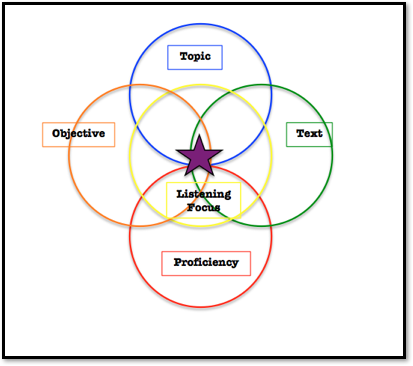|

Dawn E. McCormick
|
|

Heather McNaught
|
Teachers often feel constrained by the demands of teaching a set curriculum, but strategic inclusion of podcasts allows teachers to introduce novel, authentic materials while appealing to listeners’ interests (Brown & Lee, 2015). Authentic materials are considered to be “genuine input” (Brown, 2011) because they are created for “real-life,” not the classroom. Students often remark that, “People on the street don’t talk like my ESL teacher does” or “I can’t understand the things that I hear on TV or radio.” Materials created for native speakers more closely mirror the language that students encounter outside of the classroom. One great source of authentic materials is Scientific American 60-second podcasts. The benefits of using these podcasts are that they are free, a transcript is provided for each podcast, they are downloadable as mp3 files, and the wide variety of topics makes it easy to find a podcast related to a particular unit or theme of a class. It should be noted that “60 seconds” in this context refers to short podcasts, not only podcasts that are exactly 60 seconds long.
Podcast activities can include the typical pre-, while-, and post listening stages. In addition, short podcasts lend themselves to “cold listening,” meaning that they are used without pre-teaching activities such as discussing the topic to activate prior knowledge or teaching new vocabulary. Students benefit from short, cold listening activities because they mirror real-life listening and high-stakes testing. These activities also provide the instructor with an opportunity to understand what students are able to do independently; however, there are few ready-made activities available for teachers that use current podcasts. In addition, the tension between maintaining student interest and developing activities that link to course goals, objectives, and student learning outcomes (GOSLOs) can discourage teachers from creating new activities. Considering objectives, however, is crucial and allows the teacher to anchor the activities within the curriculum. The purpose of this article is to provide teachers with considerations when selecting podcasts and creating activities.
Considerations
1. GOSLOs: When designing supplemental activities, using GOSLOs allows for teacher creativity while still maintaining horizontal articulation. For example, a student learning outcome that includes listening for numerical information to complete charts or graphs points to sources such as business or weather reports that provide statistical information or survey data.
2. Topic: Identify a topic that relates to the unit. This provides an opportunity for students to link back to their previous practice and develop content knowledge with the new text.
3. Proficiency level of students: When using authentic materials, student proficiency levels influence text selection and activity design. Regarding the text itself, determine the distance (time) between main ideas and details of interest. The number of items in the activity directly links to this distance between information in the text. Most proficiency levels can identify the topic of a 60-second podcast, but lower proficiency students may be challenged to answer questions about details that are only a sentence apart in that same podcast. In addition to the number of items, the item type should be appropriate for the proficiency level of the students. Items that ask students to recognize a correct response (e.g., multiple choice) and use language that exactly matches the text are a better choice for lower proficiency students. Items that ask students to produce an answer (e.g., short answer) or paraphrase are more challenging and appropriate for students at higher proficiency levels.
4. Qualities of the spoken text: In addition to the distance between information within the text, other text features should be evaluated:
-
Length: Can students remain engaged for the entire length of the text?
-
Speed: What is the timing between words (think in milliseconds), and are words distinctly separate or more closely linked together in the text (e.g., consonant to vowel: look up vs. loo-kup)?
-
Accent: Does/do the speaker(s) have an accent that is (un)familiar to the students?
-
Number of speakers: Can students easily distinguish the voice of each speaker if there are multiple speakers?
-
Vocabulary: What percent of the text vocabulary is familiar to the students?
-
Grammar: Are the grammar patterns familiar to the students?
-
Background noise, sound effects, music: Are there any sounds other than the spoken text that could interfere with or assist students’ hearing or comprehending the text?
Understanding these features of the text itself will assist in appropriate selection and activity design.
5. Listening focus: The last consideration is the listening focus of the activity, which directly cycles back to the GOSLOs. For example, students listening for numerical information could be asked if they heard “nineteen” or “ninety,” or they could be asked to complete a timeline with the dates mentioned in the text. Buck (2001) refers to considerations of language focus as choosing "aspects of language competence" (p. 105) that are appropriate for assessment.
The five considerations ideally will overlap as in the Venn diagram below, but focus on identifying a best option, not necessarily a perfect option. Adjusting the number and type of items and the number of times the text is played can compensate for anticipated challenges.

Example
-
GOSLOs: An example of a low-intermediate (approximately CEFR A2) intensive English program (IEP) GOSLOs:
Identify topic, main ideas, details, and limited inferences in low-intermediate level audio/video texts on personal, practical, social, and general topics.
Note: Identifying details could include listening for numerical information.
-
Topic: The topic of the unit is health, and the podcast must also provide students with an opportunity to listen for numerical information about health.
-
Proficiency level: At the low-intermediate level, students are able to answer multiple choice questions about authentic texts but must listen twice if target details are in contiguous sentences.
-
Qualities of the spoken text: The podcast selected is from Scientific American, “Exercise Lengthens Life Regardless of Weight,” and the following qualities have been reviewed: length (1:19), speed (faster than the textbook non-authentic texts), accent (none that would interfere in the current instructional context compared to other texts in the curriculum), number of speakers (1), vocabulary (90% of the words are within the K-1 word frequency level according to VP-Compleat), grammar (includes structures reviewed at the low-intermediate level and some beyond), and background noises, etc. (none that interfere with the speaker).
-
Listening focus: At the low-intermediate level, the listening focus will be on recognizing stated numbers.
Low-intermediate item examples could include:
-
How many people participated in the study?
a. 650 b. 6,500 c. 65,000 d. 650,000
-
How many hours of walking per week does the WHO recommend?
a. 2.5 – 5.0 b. 2.0 – 5.0 c. 2.0 – 5.5 d. 2.5 – 5.5
-
How many years are gained by people who exercised the full recommended amount?
a. 3.0 b. 3.1 c. 3.4 d. 3.6
-
How many years fewer do normal-weight, inactive people live?
a. 3.0 b. 3.1 c. 3.4 d. 3.6
-
How many extra hours of life could a person gain by exercising?
a. 300 b. 3,000 c. 30,000 d. 300,000
Contrast the items above with items designed for the same podcast, but for students at a higher proficiency level (approximately CEFR C1):
-
Number of people who participated in the study: ___________________
-
Amount of walking per week recommended by the WHO: _____________________ (hours)
-
Amount of life expectancy gained by people who exercised the full recommended amount: ____________ (years)
-
Amount of life expectancy gained by people who exercised half the recommended amount: _____________________ (years)
-
Number of years fewer that normal weight, non-exercising people live: ______________________
-
Number of extra hours of life a person could gain by exercising: _________________________
Conclusion
Strategically introducing podcasts into a curriculum can benefit students and teachers. By considering the interactions of GOSLOs, topic, student proficiency, qualities of the text, and the listening focus, teachers can make informed choices, engage students’ interest, and create new activities using authentic materials.
References
Cobb, T. (n.d.). VP-Compleat v.2 [computer program]. Accessed 14 June 2018 at https://www.lextutor.ca/vp/
Brown, H. D., & Lee, H. (2015). Teaching by principles: An interactive approach to language pedagogy (4th Ed.). New York: Pearson Education.
Brown, S. (2011). Listening myths: Applying second language research to classroom teaching. Ann Arbor, MI: Michigan University Press.
Buck, G. (2001). Assessing listening. Cambridge, UK: Cambridge University Press.
Scientific American. (2012, November 6). Exercise lengthens life regardless of weight. Retrieved from http://www.scientificamerican.com/podcast/episode/exercise-lengthens-life-regardless-12-11-06/
Dawn E. McCormick is an associate director at the English Language Institute and a senior lecturer in the Department of Linguistics at the University of Pittsburgh. She is interested in program administration, professional development, and student self-assessment.
Heather McNaught has been the assessment supervisor at the English Language Institute at the University of Pittsburgh since 2011. Prior to that, she was the head of the English Language Program at Chatham University in Pittsburgh and was a lecturer at Feng Chia University in Taichung, Taiwan. Her teaching interests focus on pronunciation, listening, and speaking. |

